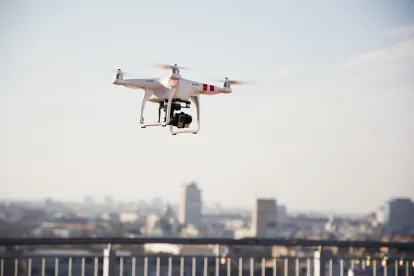The use of unmanned aerial vehicles in the design and construction industry is literally taking off. Here’s what owners, developers and construction professionals need to know.
Unmanned aerial vehicles (a.k.a. drones) are changing the way we do business. But, for one industry specifically, their impact has already been far-reaching, and the untapped potential is jaw-dropping. The use of drones in the design and construction industry has increased dramatically since 2014, when the Federal Aviation Administration (FAA) initially created the current regulatory structure for commercial users of unmanned aerial vehicles (i.e., section 333 exemptions and certificates of authorization). More than a third of all FAA applications list construction, real estate or utility/energy/infrastructure as the intended operation or mission for the drone.1 In fact, two of the first six FAA Section 333 exemptions were granted to Dayton, Ohio’s Woolpert, Inc., a design, geospatial and infrastructure management firm, to perform precision aerial surveying.2
Why are drones so perfectly situated for use in the design and construction industry? Drones are ideal for supporting the full life cycle of the development process—from design to construction to maintenance. First and foremost, drones can venture where humans and heavy machinery should not, providing valuable project data without risking human life. Most drones are very small, lightweight and equipped with high-quality imaging capabilities making them ideal to perform inspections in tight spaces or at high altitudes. Second, the data collection capabilities are mind-boggling. We have all seen the breath-taking aerial photos drones are capable of capturing. Couple that with thermal imaging, traditional surveying data, 3D scanning, object recognition and data cataloguing capabilities and everything from property due diligence to project design becomes available with the whirl of the propellers. Third, operating a drone is efficient and economical, resulting in numerous cost-saving benefits for a construction project. In addition to the safety aspect of utilizing drones, a drone can do most jobs a lot faster and a lot more precisely than its human counterparts. For example, drones are already being programmed to follow pre-determined flight paths and deliver daily site reports, allowing developers and contractors to better track construction progress, measure stockpiles, manage resources, reduce downtime, and help construction projects stay on schedule and under budget.3
Federal and local laws impose a number of requirements on the commercial use of drones that are beyond the scope of this article, such as holding an Airmen’s Certificate, obtaining a Section 333 Exemption, and restrictions on altitude and flight locations. But, in addition to those and other common concerns of all commercial drone users, the construction and development industry has some distinct considerations to keep in mind when conducting drone flights on project sites:
1. Project Site Owner and Occupant Notices.
You need the property owner’s permission to conduct the flight. Remember, the developer of a property is not always the property owner. If you are the contractor or a subcontractor, know the ownership of your project site and involve that entity, as well as the entity you are directly contracted with, in the plan to use a drone on the site.
Notice down the food chain is just as important as notice up the food chain. As an owner, developer, or general contractor on the job, do not assume that you do not need to notify the subcontractors and material suppliers on the site of the impending drone flight. You may not need their permission, but your Section 333 exemption will require you to notify these entities and maintain a clear distance from any unprotected individuals on the site.
Arguably, drones are fairly quiet as compared to other pieces of construction equipment. But when operated in tight spaces between buildings, the noise can reverberate. Extended flight times also pose more danger of annoying the neighbors. Notice to adjacent property owners as a courtesy is prudent and could save you time and headache. This is particularly true if the development upon which the drone flight will be conducted is in an urban environment or adjacent to a sensitive use, such as a funeral home, hospital, retirement home, daycare or other facility where disturbance or danger to the inhabitants is highly discouraged if not prohibited. Sending a notice to neighboring land owners concerning the impending use of a drone, the duration and approximate time of day the flight will take place, as well as whether this will be a one-time or repeated exercise, eliminates surprise, provides an opportunity to accommodate any special needs and may prevent a site visit from local law enforcement.
2. Site Due Diligence and Worksite Monitoring.
Just like any due diligence study performed on a property prior to purchase, the owner of the property should always be cautious about the data that others collect while determining if the site can be developed. Drone data and imagery collected to prepare site feasibility studies, wetlands analyses, or identify hazardous materials should be regarded as proprietary material just as much as an environmental study, geotechnical report or ALTA/NSPS survey. The entity collecting the data, whether directly or through a third-party consultant, should execute a non-disclosure agreement before taking flight and also destroy or transfer all drone data to the owner if foregoing the opportunity to acquire or develop the property.
If you are considering using a drone to perform construction site inspections or document construction progress, proceed with caution. Delegating your on-site inspection to a drone could leave you with hours of video and hundreds of images to review. If you do not review all imagery captured or you misinterpret the imagery, you might open yourself up to claims of professional negligence.4 This is commonly referred to as the risk of having too much information. Design and construction professionals “need to clearly outline, and usually disclaim, any responsibility to determine if the drone indicates whether or not the project is being constructed in conformance with the contract documents for the project. And, in compliance with a firm’s document retention policy, unrequested or unused information, such as the recording of a video feed, could then be discarded to avoid future attempts to place responsibility on the design firm beyond its contractual obligations.”5
Interested in monitoring workers or documenting work rule violations? At least one local union in Philadelphia has deployed drones to monitor non-union work-sites and union protests at those sites.6 But beware—this is a controversial use that has more than a few labor law implications (including unauthorized surveillance of union and non-union workers, alike—an issue monitored by the National Labor Relations Board) as well as the more typical property and individual rights issues, like trespass and violation of privacy.
3. Use and Ownership of Drone Data.
Some drones can collect highly accurate topographic imagery and point clouds. But the conversion of that data into a file type that can be imported into another software platform, such as AutoCAD or a BIM platform, for design or analysis may be a tedious, multi-step conversion that could introduce user errors. What party in the collection, design, and construction process takes responsibility for those incompatibilities? Do your contracts spell out these liabilities and assign risk? If you hired a third-party consultant specifically to perform the drone functions on the project and hand over the data, do they retain some rights to use the data? After design and construction, can drone imagery be captured and used by your contractor or a subcontractor for marketing purposes? Your due diligence, design and construction contracts should clearly spell out these expectations and shift the risk appropriately.
4. Drone Insurance.
If you have not had a conversation with your insurance carrier about your use of a drone, most likely you are not covered under your existing policy. Your commercial general liability (CGL) policy probably contains an exclusion for “unmanned aircraft.” If so, you need to have a drone-specific endorsement or stand-alone drone policy to affirmatively cover your drone use. Which option is best for you and how much insurance you need should be discussed with your agent, but you should specifically inquire about the difference between “Coverage A” and “Coverage B,” which pertains to bodily injury/property damage and personal/advertising injury coverage, respectively. Development and construction professionals that subcontract for drone operation services should make sure that the firm operating the drone has appropriate coverage but you may also want to carry additional insurance over and above the third-party provided coverage.
Be careful about the limits of coverage you choose. Monetary thresholds could be set forth in the construction contract you have executed. If you are the property owner, you should set forth this requirement in your contracts as well other necessary risk-shifting provisions and operating procedures you want contractors and subcontractors to abide by. Further, excess/umbrella liability policies may not apply over and above drone endorsement limits. Know your exposure to personal liability and how the different components of your insurance coverages will and will not respond to damage or injury caused by a drone.
Drones are becoming tools just as commonly deployed on the jobsite as are total stations and jackhammers. Incorporating these considerations will go a long way towards integrating this exciting technology into your everyday toolbox.
For a checklist of the general considerations applicable to all commercial drone users, read more here.
1 Authorizations Granted Via Section 333 Exemptions, FEDERAL AVIATION ADMINISTRATION, here. (last visited April 11, 2016). See also Dan Gettinger, The Drone Exemptions, CENTER FOR THE STUDY OF DRONE, BARD COLLEGE (April 8, 2015), here (commenting on the proliferation of exemptions granted to construction and infrastructure development uses).
2 Authorizations Granted Via Section 333 Exemptions, FEDERAL AVIATION ADMINISTRATION, here (last visited April 11, 2016).
3 John Caulfield, Drones Aren’t Just a Curiosity Anymore for AEC Firms, BUILDING DESIGN+CONSTRUCTION (Mar. 18, 2016), here.
4 Victor O. Schinnerer & Company, Inc. and CNA Insurance, Drone: Bird, Plane, Predator or Liability?, AIA TRUST, available here (last visited April 12, 2016).
5 Victor O. Schinnerer & Company, Inc. and CNA Insurance, Drone: Bird, Plane, Predator or Liability?, AIA TRUST, available here (last visited April 12, 2016)
6 That is, had deployed its drone—the International Brotherhood of Electrical Workers Local 98’s drone was grounded in late March until it can come into compliance with FAA regulations. Apparently, the FAA was monitoring the union, too. Bobby Allyn, Philly Electricians’ Drone Contingent Still Grounded, Awaiting Federal Approvals, NEWSWORKS (Mar. 30, 2016) here.



 />i
/>i
